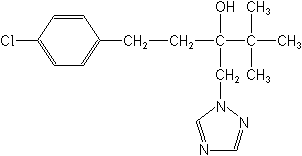Products >> Fungicides >> Tebuconazole
Tebuconazole
Tebuconazole 95%TC
Tebuconazole 80%WP
Tebuconazole 25%EC
Tebuconazole 12%FS
Tebuconazole 6%FS
Fungicide
FRAC 3; DMI: triazole

Tebuconazole NOMENCLATURE
Common name tebuconazole (BSI, draft E-ISO)
IUPAC name (RS)-1-p-chlorophenyl-4,4-dimethyl-3-(1H-1,2,4-triazol-1-ylmethyl)pentan-3-ol
Chemical Abstracts name (?-a-[2-(4-chlorophenyl)ethyl]-a-(1,1-dimethylethyl)-1H-1,2,4-triazole-1-ethanol
Other names fenetrazole*; terbuconazole*; terbutrazole*; ethyltrianol*
CAS RN [107534-96-3] EEC no. ELINCS: 403-640-2 Development codes
HWG 1608 (Bayer)
Tebuconazole APPLICATIONS
Biochemistry Steroid demethylation (ergosterol biosynthesis) inhibitor.
Mode of action Systemic fungicide with protective, curative, and
eradicant action. Rapidly absorbed into the vegetative parts of
the plant, with translocation principally acropetally. Uses As a
seed dressing, tebuconazole is effective against various smut and
bunt diseases of cereals such as Tilletia spp., Ustilago spp., and
Urocystis spp., also against Septoria nodorum (seed-borne), at 1-3
g/dt seed; and Sphacelotheca reiliana in maize, at 7.5 g/dt seed.
As a spray, tebuconazole controls numerous pathogens in various
crops including: rust species (Puccinia spp.) at 125-250 g/ha, powdery
mildew (Erysiphe graminis) at 200-250 g/ha, scald (Rhynchosporium
secalis) at 200-312 g/ha, Septoria spp. at 200-250 g/ha, Pyrenophora
spp. at 200-312 g/ha, Cochliobolus sativus at 150-200 g/ha, and
head scab (Fusarium spp.) at 188-250 g/ha, in cereals; leaf spots
(Mycosphaerella spp.) at 125-250 g/ha, leaf rust (Puccinia arachidis)
at 125 g/ha, and Sclerotium rolfsii at 200-250 g/ha, in peanuts;
black leaf streak (Mycosphaerella fijiensis) at 100 g/ha, in bananas;
stem rot (Sclerotinia sclerotiorum) at 250-375 g/ha, Alternaria
spp. at 150-250 g/ha, stem canker (Leptosphaeria maculans) at 250
g/ha, and Pyrenopeziza brassicae at 125-250 g/ha, in oilseed rape;
blister blight (Exobasidium vexans) at 25 g/ha, in tea; Phakopsora
pachyrhizi at 100-150 g/ha, in soya beans; Monilinia spp. at 12.5-18.8
g/100 l, powdery mildew (Podosphaera leucotricha) at 10.0-12.5 g/100
l, Sphaerotheca pannosa at 12.5-18.8 g/100 l, scab (Venturia spp.)
at 7.5-10.0 g/100 l, white rot in apples (Botryosphaeria dothidea)
at 25 g/100 l, in pome and stone fruit; powdery mildew (Uncinula
necator) at 100 g/ha, in grapevines; rust (Hemileia vastatrix) at
125-250 g/ha, berry spot disease (Cercospora coffeicola) at 188-250
g/ha, and American leaf disease (Mycena citricolor) at 125-188 g/ha,
in coffee; white rot (Sclerotium cepivorum) at 250-375 g/ha, and
purple blotch (Alternaria porri) at 125-250 g/ha, in bulb vegetables;
leaf spot (Phaeoisariopsis griseola) at 250 g/ha, in beans; early
blight (Alternaria solani) at 150-200 g/ha, in tomatoes and potatoes.
Phytotoxicity Good plant compatibility in most crops with any formulation,
and achieved in more sensitive crops by appropriate formulations,
e.g. WP, WG or SC. Formulation types DS; EC; ES; EW; FS; GF; SC;
SE; WG; WP; WS. Selected tradenames: 'Folicur' (spray) (Bayer);
'Horizon' (spray) (Bayer); 'Raxil' (seed treatment) (Bayer); 'Elite'
(spray, USA) (Bayer Corp.); mixtures: 'Matador' (+ triadimenol)
(spray) (Bayer); 'Pronto Plus' (+ spiroxamine) (spray, Germany)
(Bayer); 'Raxil S' (+ triazoxide) (seed treatment) (Bayer)
Tebuconazole ANALYSIS
Residues in soil, water and plant material determined by glc (W.
Maasfeld, Pflanzenschutz-Nachr. Bayer (Engl. Edn.), 1987, 40, 29;
H. Allmendinger, ibid., 1991, 44, 5). Details available from Bayer.
Tebuconazole MAMMALIAN TOXICOLOGY
Reviews FAO/WHO 71, 73 (see part 2 of the Bibliography). Oral Acute
oral LD50 for male rats 4000, female rats 1700, mice c. 3000 mg/kg.
Skin and eye Acute percutaneous LD50 for rats >5000 mg/kg. Non-irritating
to skin; mild irritant to eyes (rabbits). Inhalation LC50 (4 h)
for rats 0.37 mg/l air (aerosol), >5.1 mg/l (dust). NOEL (2 y)
for rats 300, dogs 100, mice 20 mg/kg diet. ADI (JMPR) 0.03 mg/kg
b.w. [1994]. Toxicity class WHO (a.i.) III; EPA (formulation) II
('Elite' 45DF); III ('Folicur' 3.6F) EC hazard (Xn; R22)
Tebuconazole ECOTOXICOLOGY
Birds Acute oral LD50 for male Japanese quail 4438, female Japanese
quail 2912, bobwhite quail 1988 mg/kg b.w. Dietary LC50 (5 d) for
mallard ducks >4816, bobwhite quail >5000 mg/kg feed. Fish
LC50 (96 h) for rainbow trout 4.4, bluegill sunfish 5.7 mg/l (flow
through). Daphnia LC50 (48 h) 4.2 mg/l (flow through). Algae ErC50
(96 h) for Scenedesmus subspicatus 4.01 mg/l (static). Other aquatic
spp. No effect on Chironomus riparius at 0.1 mg/l (28 d). Bees LD50
(48 h) (oral) 175.8 mg/bee; (contact) 0.6 mg/bee. Worms Acute LC50
(14 d) for Eisenia foetida 1381 mg/kg dry soil. Other beneficial
spp. No adverse effects on ground dwellers, e.g. ground beetles
(Poecilus cupreus) (adults and larvae) or on foliage dwellers, e.g.
ladybirds (Coccinella septempunctata), up to 375 g/ha (EW 250 formulation).
Tebuconazole ENVIRONMENTAL FATE
Animals After three days, elimination was almost complete (>99%).
Tebuconazole was excreted with the urine and the faeces. Plants
Metabolism studies on wheat, grapes and peanuts show that tebuconazole
is the major terminal residue. The metabolites detected were mainly
triazole-containing compounds of no toxicological relevance. In
plant tissue, a mean half-life of 12 days could be derived (cereals).
Soil/Environment The degradation of tebuconazole in soil was slow
in laboratory studies. Under field conditions, the compound degraded
much more rapidly, and did not accumulate in long-term studies (3-5
y). Since no residues could be detected in deeper soil layers of
these and other studies, and adsorption/desorption studies indicated
a low mobility in the soil, groundwater contamination through leaching
can be excluded. In natural waters, hydrolysis and indirect photolysis
occur; in a pond study, the compound dissipated from the water body
with DT50 1-4 w. Low vapour pressure and strong adsorption result
in low volatilisation into the air.